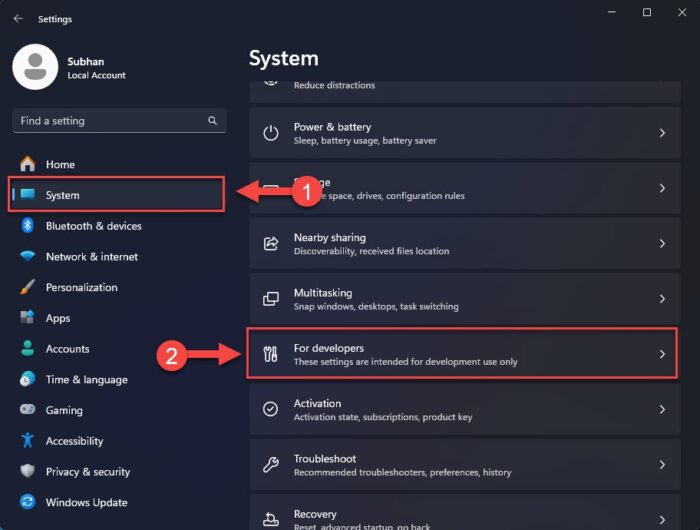Windows 11 has a hidden developer feature where the operating system allows you to view and manage the computer remotely through a web-based portal. It lets you view the information locally, or remotely on the same internal network through a web browser.
The Windows Device Portal (WDP) allows you to monitor, diagnose, and troubleshoot the Windows PC remotely through the Device Portal. It provides real-time information on the resource utilization, running processes, and connectivity engaged with the machine.
By default, the Windows Device Portal functionality is disabled. It needs to be enabled and configured before you can access the portal remotely. This guide will show you how to enable the Device Portal, how to access it, and how it can be used.
Table of Contents
What is the Windows Device Portal

The Windows Device Portal (WDP) is a web server that comes inside Windows 11. When configured, it allows users to remotely access the device’s performance metrics over the network or a USB connection to monitor and control the Windows PC.
With WDP, you can not only monitor how the system is behaving but also control it, such as terminate tasks, manage apps, configure device settings, and much more. Here are a few things the Device Portal allows you to manage remotely:
- Manage Windows settings
- Monitor system resource consumption and performance metrics
- View and manage background processes
- install, modify, or uninstall apps
- View and manage Wi-Fi profiles and signal strength
- Collect and view dump files and system logs
- Troubleshoot issues
- Manage files and folders remotely
Rather than accessing a remote PC through RDC, you can use the Device Portal to manage the device better, remotely, directly through your web browser.
How to enable Windows Device Portal
WDP is only available on Windows 11. On the computer that you want to manage remotely through WDP, implement the following steps to enable the feature:
-
Press the Windows key + i to launch the Settings app.
-
Click System.
-
Go to “For Developers“.

Open For Developers settings -
Enable “Developer Mode“.

Enable Developer Mode -
When asked for confirmation, click Yes.

Confirm enabling Developer Mode -
Now enabled “Device Portal“.

Enable Device Portal -
When asked to install the “Windows Developer Mode package“, click Yes
-
Once installed, enable “Authentication” and then click Edit.

Enable authentication -
Enter a username and a password, and click Apply.
These credentials will be used to access the Device Portal remotely.

Enter username and password -
When asked for confirmation, click Yes.

Confirm username and password for Device Portal
How to access the Windows Device Portal
After performing the steps above, the Windows Device Portal will be successfully set up. You may then continue to access the portal using the given URLs in the Device Portal section.

You can access the Device portal on the same device by entering the “localhost” URL (along with the provided port) in a browser on the same PC. To access the Device Portal on a computer on the network, use the respective URL instead.
Here are the steps to follow when accessing the Device Portal remotely:
-
Open a web browser on the remote PC and enter the respective URL.
For example, in this example, I will enter “HTTP://192.168.100.167” into the Omnibox in the URL.
-
On the welcome page, select the option “Don’t show again” and click “Continue with an unsecured connection“.

Continue with an unsecured connection -
Now, enter the credentials for the Device Portal and click “Sign in“.

Enter credentials and sign in
You should now see the Device Portal. As you can observe, the portal provides a plethora of settings and managing sections, divided into tabs that are visible on the left. You can now continue to monitor and manage your Windows 11 PC remotely.
Features of Windows Device Portal
As soon as you connect to a Device Portal, you are on the “App Manager” tab. On the top, you see the battery percentage and power options for the remote PC.

Now you have the power to restart or shut down the remote OC.
While on the App Manager page, you can deploy packaged apps from the local, network, or web hosts. You can even install or run them. Additionally, you can get information about the running apps or close them if needed.
You also have a “File Explorer” tab on the left, which allows you to navigate through the different files, folders, and directories on the folder with such speed as if it were on the local computer. Using this option, you can create, manage, move, and delete files and folders as you please.
The “Running processes” tab lets you manage the processes running on the PC, like the Task Manager. You can see the process IDs from here, see how many resources each process is consuming, or even end the processes by clicking on the “X” mark.

Additionally, you can also view the connectivity status of the device using different mediums. For example, you can view the status of Bluetooth and Wi-Fi connectivity on the Bluetooth and the Networking tabs respectively.
The Windows Device Portal also provides some other interesting features, such as performance and log tracing. To read all about the Windows Device Portal and what it is capable of, read this Microsoft guide post.
Ending words
The Windows Device Portal, unlike the regular RDP session, is solely web-based. It does not provide a GUI of the Windows you have connected to remotely. Instead, you see all the statistics and reports of the report PC inside the browser in real time.
This makes the Device Portal lightweight for the PC while providing more accurate statistics and manageability controls.
At the moment, Device Portal is only available for Windows 11 devices but can be accessed through any device on the network.



